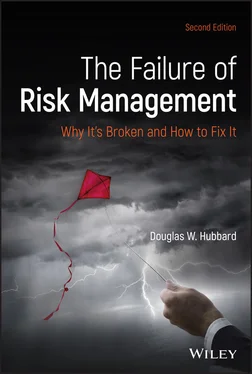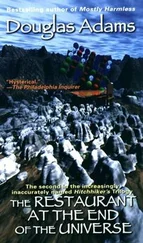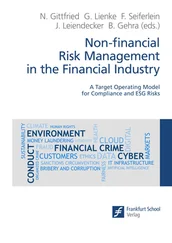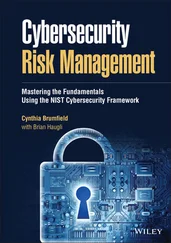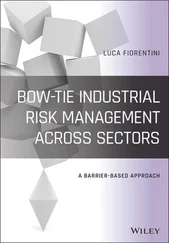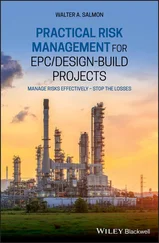Lacking real evidence of effectiveness, some practitioners will employ some of the previously mentioned defenses. We will address at least some of those arguments in subsequent chapters, and we will show how some of those same arguments could have been used to make the case for the “validity” of astrology, numerology, or crystal healing. When managers can begin to differentiate the astrology from the astronomy, then they can begin to adopt methods that work.
RISK MANAGEMENT SUCCESS-FAILURE SPECTRUM
1 Best. The firm builds quantitative models to run simulations; all inputs are validated with proven statistical methods, additional empirical measurements are used when optimal, and portfolio analysis of risk and return is used. Always skeptical of any model, the modelers check against reality and continue to improve the risk models with objective measures of risks. Efforts are made to systematically identify all risks in the firm.
2 Better. Quantitative models are built using at least some proven components; the scope of risk management expands to include more of the risks.
3 Baseline. Intuition of management drives the assessment and mitigation strategies. No formal risk management is attempted.
4 Worse (the merely useless). Detailed soft or scoring methods are used, or perhaps misapplied quantitative methods are used, but at least they are not counted on by management. This may be no worse than the baseline, except that they did waste time and money on it.
5 Worst (the worse than useless). Ineffective methods are used with great confidence even though they add error to the evaluation. Perhaps much effort is spent on seemingly sophisticated methods, but there is still no objective, measurable evidence they improve on intuition. These “sophisticated” methods are far worse than doing nothing or simply wasting money on ineffectual methods. They cause erroneous decisions to be made that would not otherwise have been made.
A firm that conducts an honest evaluation of itself using the prescribed methods will find it falls somewhere along a spectrum of success and failure. Based on the standards I've described for the success of risk management, the reader has probably already figured out that I believe the solution to be based on the more sophisticated, quantitative methods. You may not yet be convinced that such methods are best or that they are even practical. We'll get to that later. For now, let's look at the proposed success/failure spectrum. (See the Risk Management Success-Failure Spectrum box.)
Note that in this spectrum doing nothing about risk management is not actually the worst case. It is in the middle of the list. Those firms invoking the infamous “at least I am doing something” defense of their risk management process are likely to fare worse. Doing nothing is not as bad as things can get for risk management. The worst thing to do is to adopt an unproven method—whether or not it seems sophisticated—and act on it with high confidence.
1 1. Some of the details of this are modified to protect the confidentiality of the firm that presented the method in this closed session, but the basic approach used was still a subjective weighted score.
2 2. C. Tsai, J. Klayman, and R. Hastie, “Effects of Amount of Information on Judgment Accuracy and Confidence,” Organizational Behavior and Human Decision Processes 107, no. 2 (2008): 97–105.
3 3. C. Heath and R. Gonzalez, “Interaction with Others Increases Decision Confidence but Not Decision Quality: Evidence against Information Collection Views of Interactive Decision Making,” Organizational Behavior and Human Decision Processes 61, no. 3 (1995): 305–26.
4 4. Stuart Oskamp, “Overconfidence in Case-Study Judgments,” Journal of Consulting Psychology 29, no. 3 (1965): 261–65, doi: 10.1037/ h0022125. Reprinted in Judgment under Uncertainty: Heuristics and Biases, ed. Daniel Kahneman, Paul Slovic, and Amos Tversky (Cambridge, UK: Cambridge University Press, 1982).
5 5. P. Andreassen, “Judgmental Extrapolation and Market Overreaction: On the Use and Disuse of News,” Journal of Behavioral Decision Making 3, no. 3 (July–September 1990): 153–74.
6 6. D. A. Seaver, “Assessing Probability with Multiple Individuals: Group Interaction versus Mathematical Aggregation,” Report No. 78–3 (Los Angeles: Social Science Research Institute, University of Southern California, 1978).
7 7. S. Kassin and C. Fong, “I'm Innocent! Effects of Training on Judgments of Truth and Deception in the Interrogation Room,” Law and Human Behavior 23 (1999): 499–516.
8 8. D. Kahneman and G. Klein, “Conditions for Intuitive Expertise: A Failure to Disagree,” American Psychologist (September 2009): 515–26.
9 9. “It's Academic,” Stanford GSB Reporter (April 24, 2000): 14–15.
10 10. E. Zuckerman and J. Jost, “What Makes You Think You're So Popular? Self-Evaluation Maintenance and the Subjective Side of the ‘Friendship Paradox,’” Social Psychology Quarterly 64, no. 3 (2001): 207–23.
11 11. D. M. Messick, S. Bloom, J. P. Boldizar, and C. D. Samuelson, “Why We Are Fairer Than Others,” Journal of Experimental Social Psychology 21 (1985): 480–500.
12 12. N. D. Weinstein, “Unrealistic Optimism about Future Life Events,” Journal of Personality and Social Psychology 39 (1980): 806–20.
13 13. O. Svenson, “Are We All Less Risky and More Skillful Than Our Fellow Drivers?” Acta Psychologica 47 (1981): 143–48.
14 14. D. Dunning and J. Kruger, “Unskilled and Unaware of It: How Difficulties in Recognizing One's Own Incompetence Lead to Inflated Self-Assessments,” Journal of Personality and Social Psychology 77, no. 6 (1999): 121–34.
15 15. N. Nohria, W. Joyce, and B. Roberson, “What Really Works,” Harvard Business Review (July 2003).
16 16. H. Bühlmann, “The Actuary: The Role and Limitations of the Profession since the Mid-19th Century,” ASTIN Bulletin 27, no. 2 (November 1997): 165–71.
Конец ознакомительного фрагмента.
Текст предоставлен ООО «ЛитРес».
Прочитайте эту книгу целиком, на ЛитРес.
Безопасно оплатить книгу можно банковской картой Visa, MasterCard, Maestro, со счета мобильного телефона, с платежного терминала, в салоне МТС или Связной, через PayPal, WebMoney, Яндекс.Деньги, QIWI Кошелек, бонусными картами или другим удобным Вам способом.
